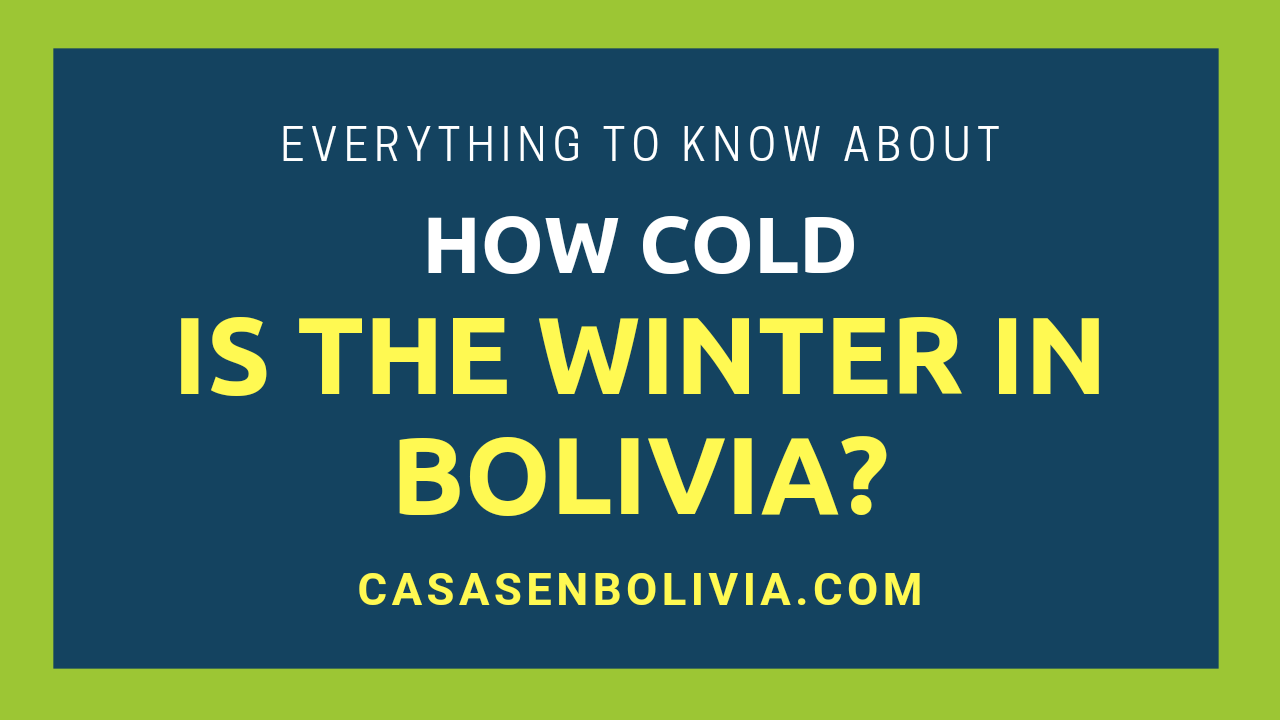Last Updated on February 15, 2025
Bolivia experiences its coldest temperatures during winter, but the intensity of the cold varies significantly across the country’s diverse regions and climates. In some areas, you’ll be comfortable wearing light clothing during winter, while in others, you’ll need thick apparel even during the day.
Bolivia is colder in winter than in other seasons, particularly from June to July. The average temperature during this season is roughly 50°F (10°C) in the Altiplanic West, 60°F (16°C) in the central region, and 70°F (21°C) in the tropical East. Days are also sunnier and drier across the country.
We are Bolivian citizens who have spent our entire lives in this country. Here, we’ll provide all the details about how cold Bolivia gets in winter, including specific figures, facts, and details for the different regions and climates. You’ll also learn key details about winter in each of Bolivia’s major cities.
A General Overview of Winter Cold in Bolivia
Winter in Bolivia, which runs from June 21st to September 20th, is typically coldest at the beginning, *specifically in late June and most of July*. Temperatures begin to rise in late July, continuing through August and September, leading into spring. This pattern occurs throughout the country, across the different climatic regions.
During winter in Bolivia, you can expect:
- In the Altiplanic West: Quite cold temperatures, with freezing temperatures, particularly at night. This region experiences almost no rain during this season, with very sunny but cold days and many freezing nights. Average temperatures are around 60°F (16°C) during the day and 40°F (4°C) at night.
- In the hilly center: Somewhat cold temperatures. While this region typically has a temperate, enjoyable climate, during winter it *will feel genuinely cold, especially at night*. You’ll need to transition from light clothing to warmer apparel to protect yourself against the cold nights. Average temperatures are around 70°F (21°C) during the day and 50°F (10°C) at night.
- In the tropical East: Still warm temperatures, *but with some days of significant cold* due to the “Surazo” climate phenomenon. Bolivians in eastern Bolivia refer to “Surazos” as wild, dry, and cold winds originating from the South Pole. These winds can last for a few days and are present only during winter and part of autumn in this region. Beyond this, you’ll still experience tropical and warm conditions, but drier, with less precipitation and slightly cooler temperatures. Average temperatures are around 80°F (27°C) during the day and 60°F (16°C) at night.
Winter often brings the coldest day of the year. However, this doesn’t always occur during winter; some years, it happens at the end of fall, or in early June. You can expect the coldest night in Bolivia to be between the second and fourth weeks of June.
Winter Cold in Bolivia’s Three Main Climate Zones
As mentioned in the previous section, winter temperatures in Bolivia vary considerably *depending on the climate zone*. The country has three distinct climates:
- The Altiplanic West, with a dry, alpine climate. Four major cities are in this region: La Paz, El Alto, Oruro, and Potosí. During winter, the average temperature here is 60°F (16°C) during the day and 40°F (4°C) at night.
- The hilly and rugged Center, with a temperate, somewhat humid climate. Three major cities are in this region: Cochabamba, Sucre, and Tarija. During winter, the average temperature here is 70°F (21°C) during the day and 50°F (10°C) at night.
- The tropical East, with a warm, humid climate. Three major cities are in this region: Santa Cruz de la Sierra, Trinidad, and Cobija. During winter, the average temperature here is 80°F (27°C) during the day and 60°F (16°C) at night.
As you can see, there’s a difference of approximately 10 Fahrenheit degrees (+10°F) as you move from a colder climate to a warmer one in Bolivia, for both daytime and nighttime temperatures.
This means, for example, that nighttime temperatures in winter will reach freezing levels in western Bolivia but will remain temperate in the east. Similarly, while days will be noticeably cold in Santa Cruz, they’ll still be considered warm compared to the cold days of La Paz in winter. You can draw many other associations from this information.
Winter Cold in Bolivia’s 10 Principal Cities
Now, let’s discuss how winter manifests in Bolivia’s principal cities, highlighting the most significant aspects of each.
La Paz
La Paz is a cold city for most of the year, but it becomes colder and drier in winter. Nights typically don’t reach freezing temperatures except during the first weeks of June, and daytime temperatures during this season are quite cold, comparable to summer nights. Residents commonly wear thick clothing both during the day and at night.
Rainfall is rare in La Paz during winter, but snowfall occurs on a few days, typically 2 or 3 days during the season. Hail is also uncommon during winter. The sun is very strong during this season, so it’s recommended to use appropriate sun protection.
La Paz’s average winter temperatures: 60°F (16°C) during the day, 40°F (4°C) at night.
El Alto
El Alto is perhaps Bolivia’s coldest major city, and it becomes extremely cold in winter. You can expect freezing temperatures almost every night from June to July. Daytime temperatures during this period are also cold and dry, though not reaching freezing levels.
This city is near La Paz, but it has a higher elevation of 13,323 ft (4,061 m). This is why temperatures in El Alto are even colder. Snowfall is common in El Alto during winter. During this time, the sun is consistently present without any clouds and with much more intense radiation than usual. Ensure you use adequate sun protection in this city.
El Alto’s average winter temperatures: 50°F (10°C) during the day, 30°F (-1°C) at night.
Cochabamba
Cochabamba typically has a mild climate and somewhat humid air throughout most of the year. However, in winter, temperatures drop noticeably. During this month, particularly from June to July, and sometimes in May, nights are cold, and some nights (1 to 3) may reach freezing levels.
During the day, winter temperatures in this city will allow you to wear light clothing, as it’s still warm enough. However, at night, unlike in other seasons when you can comfortably go out in just a T-shirt and shorts, you’ll need to wear warmer clothing, *and you’ll genuinely feel the cold climate*.
Cochabamba’s average winter temperatures: 70°F (21°C) during the day, 50°F (10°C) at night.
Santa Cruz
Santa Cruz de la Sierra is very warm throughout the year. Even in winter, you’ll find that this city is warm enough to wear very light clothing, even at night. *However, there are times when the city’s climate turns very cold*, and this occurs during the “Surazo” climate phenomenon.
Surazos are caused by very cold and humid winds coming from the South Pole. These winds enter the city very quickly, and sometimes suddenly, causing temperatures to plummet, making it feel as cold as La Paz or El Alto. Residents of this city often describe this event as even worse than the cold in Altiplanic areas *because the humid cold feels more intense than a dry cold*. However, apart from these events, winter remains very warm in Santa Cruz.
Santa Cruz’s average winter temperatures: 75°F (24°C) during the day, 65°F (18°C) at night.
Oruro
Oruro is a city at a very high elevation, and it doesn’t benefit from the protection of a mountain range on one or more sides, as La Paz does. Therefore, it experiences very cold temperatures in winter. The coldest temperatures are typically recorded between June and the first weeks of August. Many nights in the city will drop below freezing.
It’s also common to experience several days of snow during the winter in Oruro. The coldest days in this city are typically in June, with nighttime temperatures potentially dropping well below freezing, reaching 10°F (-12°C) in some cases. Daytime temperatures are also quite cold. It seldom gets cloudy in winter in Oruro, so you have very sunny days, but the cold is still very palpable in the city during this season.
It’s worth mentioning that Oruro’s Carnival does not take place in winter; it actually occurs at the end of summer, so you won’t experience very cold temperatures during this festival.
Oruro’s average winter temperatures: 55°F (13°C) during the day, 35°F (2°C) at night.
Potosí
Potosí is another cold city in Bolivia, with a climate very similar to that of El Alto. These two cities are at almost the same elevation, around 13,400 ft (4,084 m). July is considered Potosí’s coldest month. This month falls at the beginning of winter in Bolivia, but cold temperatures begin to descend from May and start to rise again in August.
Like other Altiplanic cities in Bolivia, many freezing nights occur in June and particularly in July in Potosí, with temperatures on some nights dropping well below freezing, reaching 10°F (-12°C). Daytime temperatures are also very cold, and almost all days are sunny and dry. People typically wear warm clothing both during the day and at night during this season.
It’s worth noting that Uyuni’s Salt Flats also experience a harsh winter between June and July, *reaching temperatures between 10°F (-12°C) and 5°F (-15°C) at night*. It’s also very rare to see rain in this location during winter. The days are dry and sunny in this area during this season.
Potosí’s average winter temperatures: 50°F (10°C) during the day, 30°F (-1°C) at night.
Sucre
Sucre typically has mild weather and a temperate climate, but in winter, particularly from June to July, temperatures can drop enough to be noticeable. It’s very rare for the city to reach freezing levels even in winter; there have been around 10 days in the last 20 years with freezing nighttime temperatures.
Therefore, in Sucre during winter, you’ll still have warm temperatures during the day, allowing for light clothing. However, at night, unlike in other seasons when you can still go out with just a T-shirt and shorts, you’ll need to wear warmer clothing. Precipitation also decreases during this season in the city.
Sucre’s average winter temperatures: 70°F (21°C) during the day, 50°F (10°C) at night.
Tarija
Tarija is another Bolivian city that enjoys a mild climate throughout the year, but this changes in winter. During this season, temperatures drop, making nights, particularly in early July, very cold, averaging 40°F (4°C). However, it’s highly unlikely for this city to experience freezing temperatures.
On the other hand, during winter days, this city remains warm enough for comfort and light clothing. Precipitation is also lower during this season, and most days are sunny. June is the coldest month in Tarija, coinciding with the beginning of winter.
Tarija’s average winter temperatures: 70°F (21°C) during the day, 50°F (10°C) at night.
Trinidad
Trinidad is a city located right within the Amazon, and it’s very unlikely to experience cold temperatures at any time throughout the year. Even in winter, you won’t feel that this city is cold; it will remain quite warm, potentially uncomfortable if you’re not accustomed to the Amazonian climate.
Furthermore, Surazos (which commonly occur in Santa Cruz during winter) are far less frequent in Trinidad. Therefore, you won’t have these events to bring colder temperatures to the city. What differentiates winter in Trinidad is the significantly reduced precipitation, and most days will be sunny.
Trinidad’s average winter temperatures: 80°F (27°C) during the day, 70°F (21°C) at night.
Cobija
Cobija is another Bolivian city located within the Amazon, so it typically experiences an Amazonian tropical climate throughout the year, *even in winter*. Also, this city is in the far north of Bolivia, so cold winds from the South Pole almost never reach it, making Surazos very rare.
This means that Cobija enjoys a tropical climate year-round, with slightly cooler temperatures in winter, *but not significantly so*. The difference during this season is that there’s much less rainfall, and there are a few cloudy days, but most are sunny.
Cobija’s average winter temperatures: 80°F (27°C) during the day, 70°F (21°C) at night.
The Coldest Month in Winter in Bolivia
In Bolivia, it’s common for either June or July to be the coldest month of the year. *Typically, it gets very cold in late June and early July*. This period corresponds to the beginning of winter. Therefore, mostly during winter, and sometimes at the end of fall, you’ll experience the coldest climate in Bolivia.
In some cities, June is the coldest month, while in others, it’s July. For example, in Potosí, it’s July, but in La Paz, it’s June. What generally happens in the country is that temperatures begin to decrease in May, reaching their lowest point in June or July, and then start to rise again at the beginning of August.
Conclusions:
In this article about how cold Bolivia is in winter, you’ve learned that Bolivia indeed gets colder during this season, which runs from June 21st to August 20th. However, the degree of cold varies significantly depending on the climate region.
For instance, you’ve seen that in Bolivia’s Altiplanic West, nighttime temperatures typically hover near freezing, averaging 40°F (4°C), and daytime temperatures are cold, averaging 60°F (16°C). In the central region of Bolivia, which normally has a mild climate, winter brings temperatures down to 50°F (10°C) at night and 70°F (21°C) during the day. Finally, in Bolivia’s tropical East, temperatures remain almost constant, with 60°F (16°C) at night and 80°F (27°C) during the day.
You’ve also seen that Surazos are the climatic events that bring colder temperatures to Santa Cruz during winter. Additionally, La Paz is slightly warmer than Oruro, Potosí, and El Alto. Furthermore, many nights in these Altiplanic cities drop to freezing temperatures, around 10°F (-12°C). Finally, the coldest period in Bolivia is in late June and early July, both months falling within winter.
We hope this information has been helpful. If you’d like to learn every detail about the climate in Bolivia, including how cold the country gets in other seasons like autumn and spring, please visit our definitive guide here: How is the climate in Bolivia? A complete overview.
CasasenBolivia.com, information on living, working, investing, and traveling in Bolivia.








